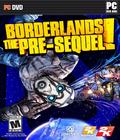Buy Borderlands: The Pre-Sequel
When Borderlands: The Pre-Sequel was originally announced, it felt like something like a cash grab to me. Surely it was a little too soon to have another entry into the series, especially one that takes place between the other two games. Even my taste of the gameplay at E3 2014 seemed to cement the thought that I wasn't going to enjoy the game. A "pre-sequel" wasn't going to change the gameplay enough to draw me back in, moon gravity and pew-pew laser weapons be damned.
I was wrong.
Fundamentally the gameplay of the Pre-Sequel isn't that different from the other titles in the series. You play as one of four new Vault Hunters, gather increasingly ridiculous armaments, and level up to unlock new abilities. However, much more important are all of the little ways the gameplay has been subtly improved. These changes are individually minor but collectively make the Pre-Sequel the most solidly built game of the series to date.
The story is told by Athena, one of the new Vault Hunters, who has been captured. Interrogating her is Lilith, the Siren from the original Borderlands, though this interrogation takes place after the events of Borderlands 2. As such, the game contains spoilers for the other games despite it being set between them chronologically. The tale revolves around the Vault Hunters being summoned to Hyperion's space station orbiting Pandora by Jack. Rather than the charismatic yet utterly villainous antagonist from Borderlands 2, in the Pre-Sequel, Jack is a lower-level grunt working for Hyperion who seems to care for protecting the innocent and doing the right thing. Between that behavior and the fact that he has a real face, the story of the Pre-Sequel covers a lot of interesting ground.
Before diving into the game, you're treated to the usual musical introduction, this time against a backing track of "Black Dragon" by The Vines. The new Vault Hunters fit the standard archetypes as before, with one notable omission. Athena is the Gladiator, who has a shield, and her special ability can be deployed to deflect incoming damage. She can then toss her shield like Captain America to a single target, and with later upgrades, it can ricochet from foe to foe. Wilhelm is the token droid deployer of the group, and his Enforcer class is able to summon attack drones that add to his damage potential. Nisha is the Gunslinger whose special ability allows her to auto-target and dispatch enemies — all to the sepia tones of an old Western. Finally, there's Claptrap, whose class is described as a Mistake.
The other characters settle into their archetypes quite well. Athena is the tank, Wilhelm is support, and Nisha is ranged damage. Claptrap represents something of a new style of play. His class can be tailored into a variety of roles and, at times, a random set of buffs and cons. As an example, if you spec his skill tree a certain way, Claptrap can randomly gain buffs to a certain class of weapons. Using this class results in crazy damage output but also serves as a massive detriment to the damage of any other weapon class — until the weapon stacks are all removed and a new class is selected.
His special ability is a straight-up lottery; it's influenced but not quite dictated by what's going on in the game at the moment you fire it. Claptrap's VaultHunter.exe analyzes the current situation with metrics such as your current health/shields, if there is a Badass nearby, if there are nearby co-op partners, etc., and then somewhat randomly chooses a particular subroutine. These are inspired by the abilities of the other Vault Hunters across all three Borderlands games, but they also encompass some that Claptrap thought up on his own. Fire it off once, and you might go invisible while a distraction mini-Claptrap dubsteps around the battlefield. Fire it in a different situation, and you might turn into a walking bomb that detonates after a short fuse, taking out nearby enemies in an explosion that does obscene amounts of damage.
Much of the game takes place on Elpis, Pandora's moon. With the exception of Claptrap, who doesn't need to breathe, special care must be taken to not suffocate from walking on the moon. On paper, this sounds problematic, if not cumbersome, but enemies drop air canisters almost constantly, and oxygen can be replenished from the areas where it seeps from cracks in the ground. You can also use this air supply to initiate air jets while in midair, turning lengthy jumps into long glides over the moon's surface.
While in the air, you can press your crouch key and slam down to the surface below. This move doesn't consume additional air, but initially, it can be a little difficult to aim well. Do so, however, and you'll slam down on enemies, knocking them away, and dealing some damage in the process. Not only do you enter the fight like a high-flying badass, but it also inflicts a short-range stun as enemies are knocked away by the force of your landing.
There are also oxygen stations on the moon's surface that can be activated to create a relatively large oxygen bubble, which serves dual purposes. For starters, it allows you to refill your tank while standing within it, and you can fight in one all day without worrying about suffocation. Enemies can only be lit on fire while standing in an environment that has oxygen, so there can be a strategic element to fighting within one. Meanwhile, fighting in the normal vacuum of the moon's surface can have its own advantages. Shooting the head of an enemy does more damage and temporarily disables his force field "helmet," suffocating him and doing damage over time until the system restarts.
If you thought that the psychosis that affects people in the game's universe is limited to the people on the planet of Pandora, you'd be wrong. The inhabitants that you'll meet, do missions for, and fight against are just as nuts as ever. The Pre-Sequel doesn't stray very far in how its gameplay is structured when it comes to doing missions. The game is broken up into different large zones, and you travel between the zones and do missions before returning to a hub city to collect your rewards. Though there are new weapons in the game, including the new laser class, it's all pretty familiar.
It's the smaller aspects of the game that have a bigger impact. While opening chests is still a matter of opening it and holding a key to collect all of its loot, collecting the same from fallen enemies is done by walking close to the goodies. Weapons, customizations, and other gear must still be manually picked up, but air, ammo, cash and health are all automatically snatched. Additionally, ammunition is now automatically split among co-op partners, along with cash and Moonstones (this game's Eridium). This resolves the issue of co-op partners having to equally canvas the area, only picking up "their" ammo, and leaving the rest. Now, just grab everything, and the game sorts it out; this has a supremely positive impact on how well the cooperative gameplay flows.
While Borderlands 2 had a penchant for forcing the players to drive everywhere, the environments of the Pre-Sequel seem denser. Driving around on a Moon Buggy is still a good idea when you need to cover a lot of ground, but the game seems to rely on them less. The starting Moon Buggy vehicle is a lot like the base vehicles of the other games, but it has one major flaw. The reduced gravity takes Borderlands' questionable vehicle handling and makes it downright maddening. You'll ramp a ridge only to catch one wheel wrong on landing and uncontrollably spin the car 270 degrees. Thankfully, the first new vehicle you unlock is a single-seater that just hovers around; at that point in the game, I was just about ready to dismiss driving as a horrible mess.
If Borderlands 2 was an example of the series coasting under its own momentum, the Pre-Sequel is something of a master class in how to refine the series into a step forward. The underlying game isn't that different and it's filled with the same humor that you've come to expect, but the change of setting and the polishing of the gameplay have done wonders. The game seems more reliant on a central plot than the series is normally known for, and through it, you learn how Jack became such a horrible person. If you're like me and thought the Pre-Sequel is just another game in the series, then Claptrap's class isn't the only "Mistake." For being the third game in a franchise and with a name that implies it to be more of the same, Borderlands: The Pre-Sequel is a surprisingly fresh experience.
Score: 8.9/10
Reviewed on: Intel i5 2500k, 8gb RAM, nVidia GTX 660 Ti
More articles about Borderlands: The Pre-Sequel











 Borderlands: The Pre-Sequel launches players to Pandora’s moon for the very first time offering low-gravity gunfights while playing as four new playable characters contributing to the rise of Handsome Jack.
Borderlands: The Pre-Sequel launches players to Pandora’s moon for the very first time offering low-gravity gunfights while playing as four new playable characters contributing to the rise of Handsome Jack.



















